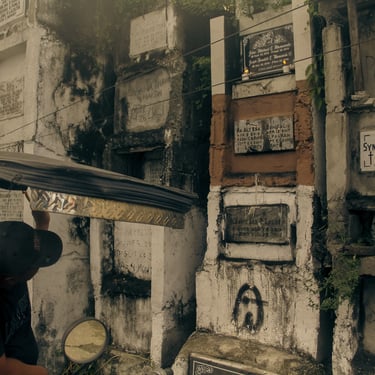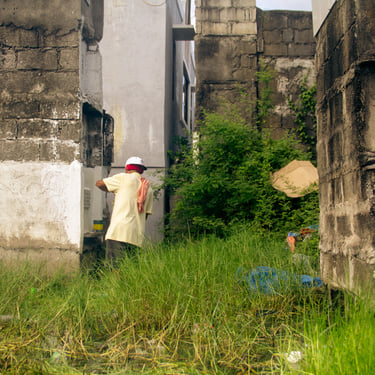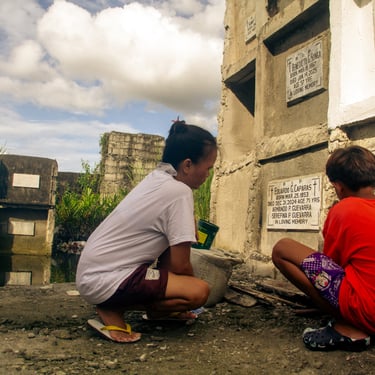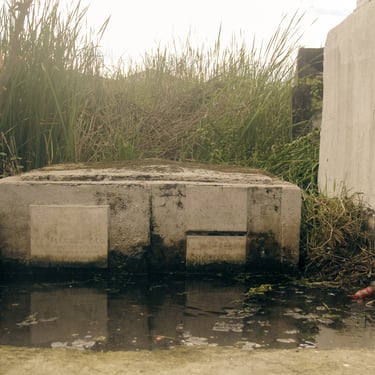All-Soak's Day: Cries of the Dead and the Alive in Masantol's Submerged Cemeteries
DEVCOMMPEOPLE

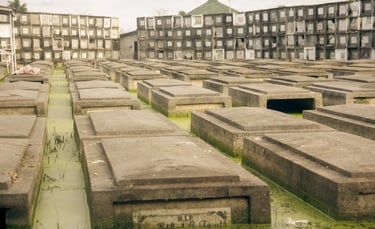
What was supposed to be a solemn day in remembering the departed once again became marred with a pitiful reality check for the bereaved.
In Barangay San Nicolas, Masantol, Pampanga, where many of the town’s cemeteries are situated, death has not been the way to escape from the horrors of the everlasting floodwaters. This is where memorial parks slowly chip out memories of the times when the sacred grounds were dry — when sorrow was only due to one’s demise. Now, emotion rises with water.
Unrest in Peace
Honoring departed loved ones of the visitors in Masantol’s cemeteries often entails wading through stagnant waters while overlooking the unfortunate scenes that seem straight out of an apocalyptic movie: columns of tombs emerge as abandoned islands, sandbags-over-sandbags to keep up with rising tides, debris and garbage float in a sea of duckweed. This is the kind of peace no one has ever wished for — even the dead.
One of the measures taken by the families to keep their departed ones’ tombs from being engulfed is simply relocating the remains into higher concrete apartments, stacking atop one after another. Jane Torno, a resident of Masantol for 19 years, is one of the witnesses to how a place supposed to symbolize peace now denotes a battle for higher ground.
She shared that the tomb of her mother who passed away just almost a year ago used to be on the topmost area but is now under the stacks of more tombs. “Malungkot, siyempre. Paano kami sasaya niyan e lumubog siya? Malungkot ‘yung sitwasyon dito sa sementeryo,” she muttered, upon asking what she feels gazing on the situation of her beloved mother on the cemetery.
Although Jane was well aware of the flooding, the nearest public cemetery, the Masantol Public Cemetery, became the only option they had during the wake of her mother. “Hindi kami nakaplano. Hindi kasi kami ready na mamamatay pala siya,” she emotionally remarked. Had they had the means, Jane said that their family would have moved the remains of the matriarch to a private memorial park unreached by floodwaters.
In Loving Memory
Having a tomb submerged only halfway now appears as a stroke of fortune, with some being completely swallowed by the floodwaters. The situation has grown so adverse that even the roof of some mausoleums are now reached by unforgiving waters. This is the reality of some of Gregorio Manansala’s departed family members. “Wala na, hindi na makita. Yung bago, nasa itaas na. Pero yung iba, wala na talaga makita. Lubog na talaga e,” he said.
For the 63-year-old municipal traffic aide, pervasive flooding in Masantol cemeteries started as early as 90s, but the extent is undeniably worse every year. “Taga-rito lang din ako sa lugar na ito e, dati mga bukid lang ‘yan e. Pero talagang kapag November, binabaha ang sementeryo,” Mang Gregorio said as he recalled the recurring problem in the area.
Dry ground also drifted away with family traditions. Baby Rose Salcedo — who travelled kilometers just to visit the tomb of her mother — recounted their experiences every Undas that they unfortunately are not able to do now. “Kasi dati, [kahit] ‘nung buhay pa ‘yung mama ko, nakakapag-stay kami ng mga ilang oras, nakaupo kami sa harap ng puntod. Hindi na namin nagagawa yun kasi lagi na, yearly na lang yung baha,” she noted.
“Nakakalungkot siya na nakakaiyak kasi, unang-una, dumayo pa kami. ‘Di namin alam kung ano pa ‘yung dadatnan namin — kung worse pa —- kasi every year nga sobrang baha nga tapos mas tumataas every year,” Baby Rose added. Like other visitors, all they can do now is honor their loved ones with candles and flowers, hoping the waters will allow them to do so the next time around.
Deep Sympathies, Deeper Waters
Mang Gregorio, who is also part of the authorities, said that assistance desks had been designated to guide the residents going into the area. The municipality also enforced sandbagging to aid the visitors in traversing certain parts of the cemetery. However, with certain parts with danger-level flood, visitors were advised to light their candles on the makeshift rack in front of the premises.
But for Jane, the sorrowful scenery calls for long-term solutions. “Kahit tatambakan ‘yan, ganon pa rin. Kailangan, gumawa sila ng bagong sementeryo, ‘yung mataas sana, para mailipat lahat sila. ‘Yung mga dito kasi kawawa,” she affirmed. With the failure of the flood control projects in town being jutted as clearly as ever, the hope lies on the restart, and not on fixing.
In Masantol, one of Pampanga’s most flood-prone towns due to land subsidence and higher tides, the flooding has not spared the dead — solutions therefore must transcend through the alive. As nobody deserves to be forgotten, no body deserves to be left underwater.
But for now, as long as the waters continue to swallow more tombs, the way of life in the land of the dead is eternal survival, not peace.
